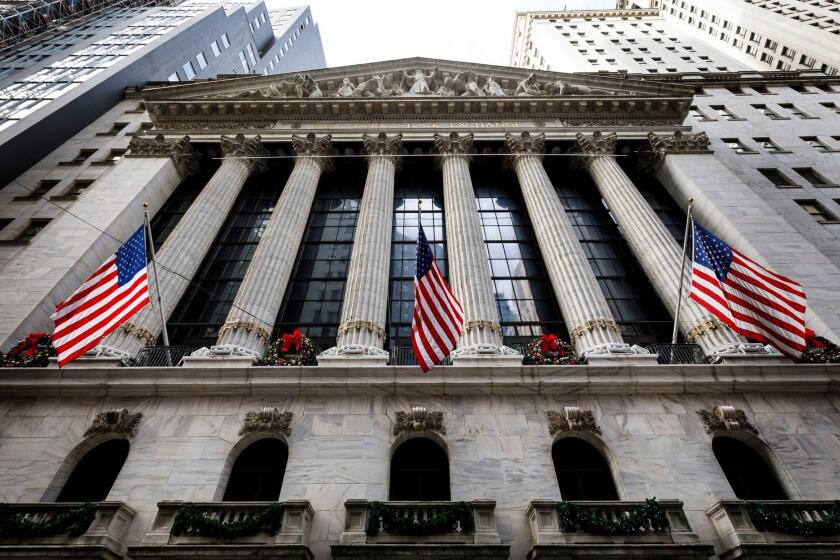Tech on a tear: Nasdaq 100 caps a $7-trillion decade with best year of bull run

In a decade of extreme wealth creation in markets, few assets did more to enrich investors than stocks in the tech-heavy Nasdaq 100 index. Their combined value jumped by more than $7 trillion, ending with the best year since the bull run began.
Powered by a near-doubling in Apple and gains exceeding 50% in Microsoft and Facebook, the Nasdaq 100 surged 38% over the last 12 months, the biggest increase since 2009.
Nearly all major asset categories scored gains in 2019. Gold climbed $5 to $1,519.50 an ounce Tuesday, to cap its best year since 2010, up 19%. West Texas intermediate crude fell 62 cents Tuesday, to $61.06 a barrel, paring its rise for the year to 35%.
Ten-year Treasuries yielded 1.92%, up three basis points for the day and down more than 75 basis points on the year. Bloomberg’s dollar index was set to end the year lower by about 1% after a 2.9% slump in the fourth quarter.
The 2008 financial crisis hit during millennials’ formative years — creating habits and fears that have kept many away from 2019’s stock market gains.
On Tuesday, the Standard & Poor’s 500 index rose 9.49 points, or 0.3%, to 3,230.78, giving it a gain of 28.9% for the year — its best performance in six years. The Dow Jones industrial average gained 76.30 points, or 0.3%, to 28,538.44, a 22.3% rise for the year. The Nasdaq composite index — which is broader than the Nasdaq 100 — climbed 26.61 points, or 0.3%, to 8,972.60 for an increase of 35.3% on the year.
Technology stocks were up 48% for the year. Financial sector stocks, especially big banks, also posted strong gains, despite a sharp pullback in interest rates. The sector ended with a 29.2% gain in 2019, while JPMorgan Chase, Bank of America and Citigroup climbed more than 40%.
Tech companies needed 15 years to recover from the dot-com crash, coming full circle in 2015. Since then, they’ve doubled again. But for all the rampant appreciation, the stocks still trade below their bubble-era highs relative to earnings. Although today’s valuation of 27 times annual profits isn’t cheap, it’s a long way from the triple-digit ratios in place when the dot-com rally crumbled.
“I told myself we’ll never see those valuations again in my lifetime, and I still think that’s true,” said Doug Ramsey, Leuthold Group’s chief investment officer. “We’ve gotten closer than I would have expected, which I think is pretty remarkable only 20 years later.”
Leuthold keeps a study plotting earnings, dividends, cash flow and other measures to compare then and now, a kind of Internet-bubble calendar that shows where the market is today relative to the 1990s. (It uses the S&P 500 as its benchmark, not the Nasdaq 100.) Going by that, it’s still only January 1998 — two years before the bubble burst.
Tech stocks have been able to rally to records even as they were beset by bad news. Regulatory scrutiny is bearing down on the sector, with Democratic presidential candidates and President Trump himself stepping up criticisms of technology firms.
Plagued by scandals, tech companies saw sentiment turn against them in the late 2010s — though not in the stock market. Users became more leery of their smartphone providers and social media mainstays. Today, consumer advocates and some antitrust enforcers are calling for the breakup of Amazon, Apple, Facebook and Alphabet’s Google, among others.
A new law that will let you opt out of the online data economy goes into effect on Jan. 1 — assuming businesses can figure out how to make that happen in time.
But compared with the dot-com run-up, the fundamentals of today’s tech giants are much sturdier than they were back then, said Bokeh Capital’s Kim Forrest.
“In 1999, there was a lot of hope in the product because there was no revenue in a lot of those companies, or very little,” said the Pittsburgh firm’s chief investment officer. “A lot of the highfliers like Uber and these consumer-orientated tech stocks, they still are unprofitable, but the difference is they have some revenue.”
In public markets, while earnings are better established, growth is getting harder to come by. Profits are likely to fall for many tech companies in 2019. Semiconductor stocks, for instance, are forecast to see a 15.4% earnings drop, and hardware and equipment makers are projected for a 6.8% retreat. In 2020, the sector is set for a rebound, with earnings growth predicted to come in above 10%, according to Bloomberg data.
The Nasdaq 100’s red-hot run has been the triumph of a few stocks over many, a state of affairs that also sows concern. Megacaps Apple, Microsoft, Amazon.com and Facebook collectively contributed almost half the Nasdaq 100’s gains over the last decade, according to data compiled by Bloomberg. Add Google’s parent and Intel, and the cohort accounts for almost 60%.
But the giants of today are cheaper than the dot-com leaders. Amazon trades at 82 times earnings now, down from north of 300 in 2001. Cisco’s multiple also topped 300 back then. It’s now at 17.
Cheap or not, they will be hard to dislodge, given their technological advancements and widespread consumer usage, said Matthew Miskin, John Hancock’s co-chief investment strategist. “It’s not just for investors,” he said. “It’s a global phenomenon, and it doesn’t look to be stopping just as the decade comes to a close.”
The Associated Press contributed to this report.
More to Read
Inside the business of entertainment
The Wide Shot brings you news, analysis and insights on everything from streaming wars to production — and what it all means for the future.
You may occasionally receive promotional content from the Los Angeles Times.












